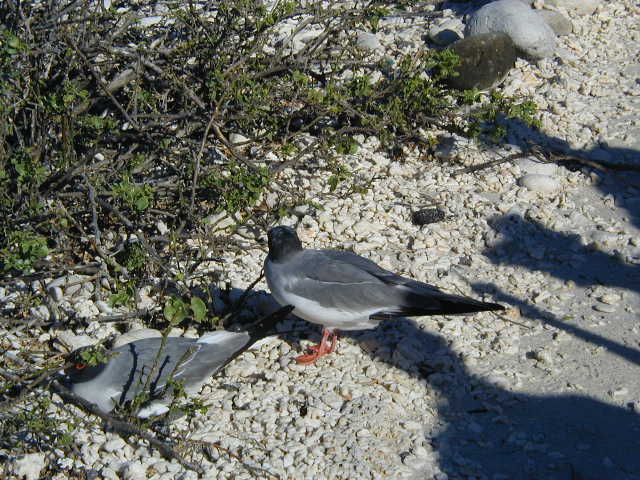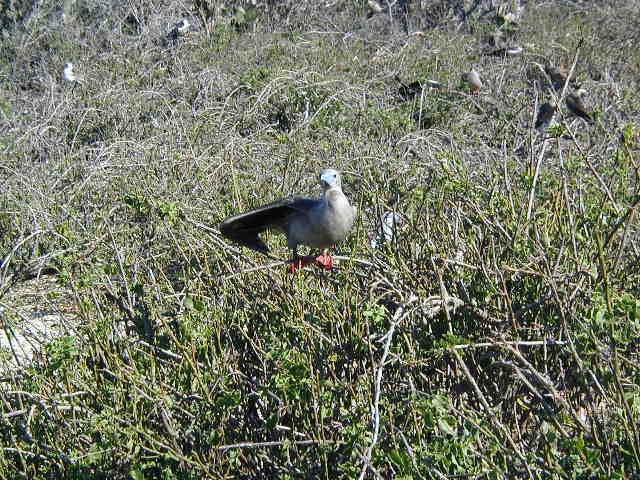
Genovesa or Tower Island was the northernmost place we visited in the Galapagos. Our first disembarkation was to a coral beach on Darwin Bay. We were immediately surrounded by a lot of swallow-tailed gulls. These have distinctive red legs and red eye rings and are the only gulls which are nocturnal feeders.

There were also a lot of frigate birds around, including many juveniles. As we took an easy stroll along the beach, we saw many red-footed boobies. A whole row of juveniles sat on the wires of the ship, by the way. I noticed one juvenile whose feet were just starting to change to red. The adults have bright blue bills and very red feet. The most unusual thing about them, though, is that they can perch in trees - not at all what one expects of birds with webbed feet.

Other sightings included a frigate bird feeding a chick, which was very odd as the chick's beak goes way inside the crop of the adult. There was also a nesting lava gull. These are rather drab but are said to be the rarest gull in the world. Rafael explained differences in sea birds based on the shapes of their tails and on wing coloration. This involved a lot of drawings in the sand, which I won't attempt to duplicate.
There was an option for a longer walk on the lava. We were told that there wouldn't really be much more wildlife on that segment, so I returned to the beach for another attempt at snorkeling. I was far more successful this time and enjoyed it quite a bit. The most interesting fish I saw was a large parrotfish, but there were several smaller, less colorful fish as well.
In the early afternoon, Jim (the video chronicler) previewed his video, showing the first 15 or so minutes of what would eventually be about 35 minutes. I immediately signed up to buy a copy, as did pretty much everybody else. That was followed by Lynn's talk and slide show about her research on tortoises and donkeys on Volcan Alcedo. The most interesting part was a series of before and after photos that showed the destructiveness of goats.
The afternoon options were a hike or a panga ride. I took a look at the photos of the lava rockfall called Prince Philip's Steps and decided that even the handrails wouldn't be enough to overcome my fear of heights. When we went by the landing area in the panga, I was glad I'd made that decision. We were able to see quite a lot of birds (and a few sea lions) from the panga. The real highlight was seeing a couple of male frigate birds with their bright red pouches inflated. That was only at binoculars distance, alas, so I don't have a photo. We also saw a frigate bird attack a red-billed tropic bird. Dora had told us that the frigate birds will grab the long tail feathers of a tropic bird and shake them until the tropic bird regurgitates its food. I didn't quite believe that until I saw it. It made me decide that frigate birds, whose feeding behavior is called "kleptoparasitism" (i.e. they steal food from other birds), are amazingly nasty.
That evening was the only one that the sky was clear enough for star gazing. We went up to the sky deck and Lynn pointed out a few constellations. I have to admit that I was a bit disappointed, as there was nowhere near the display that I saw in parts of Africa. At least the problem was clouds, not light pollution. It does give me a chance to mention my favorite bit of southern hemisphere astronomy trivia, though. Namely, the constellation Mons Mensa was named after Table Mountain near Cape Town because the astronomer who named it thought the Magellanic Clouds resembled the "tablecloth" that often covers that mountain.
Back to Previous Chapter | Back to Ecuador Index | On to Next Chapter | Xenophilia Home
last updated 20 January 2002